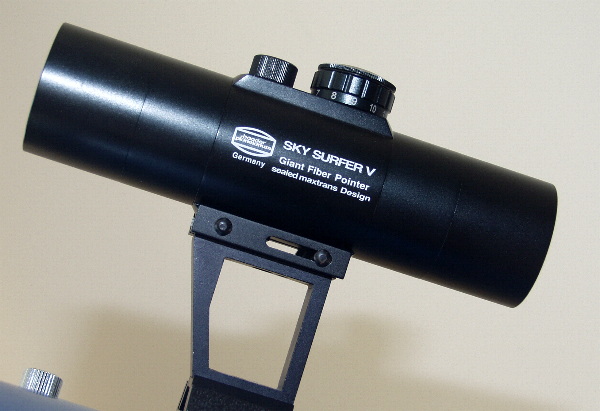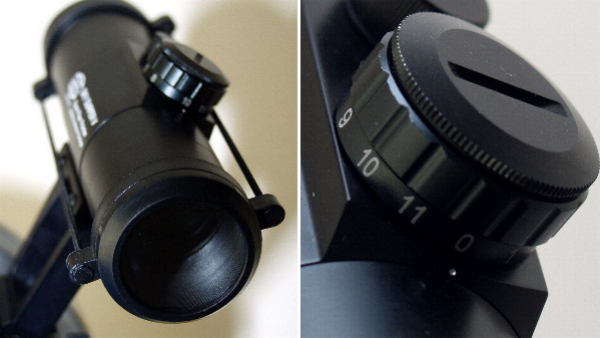 |
After a few frustrating
nights finding targets hard to locate manually with my standard 8x50 finder
scope I resolved to find a better solution for manually guiding the telescope
to its targets.
A shop around the
market place gave a range of solutions and I opted to go for a red dot finder
(RDF).
This is quite a crowded market place and in the end I opted to go
for the Baader Sky-Surfer V based on its quality appearance and apparent bomb
proof design. When you're a mobile astronomer like myself you need equipment
which is hardy enough to take a few knocks and still work reliably.
So
how does the Sky-Surfer V hold up in use ?
 |
| The Baader Sky Surfer V red dot finder showing its elongated
light/dew shields. Practical and solid throughout. |
Out of the box
What arrived was a fairly decent sized box which contained the red dot
finder, two screw-in metal lens shields, a pair of see through plastic eye caps
to protect the lenses and a veritable meccano kit of parts which allow the
Sky-Surfer V to be mounted on a wide variety of scopes.
The fittings are mostly plastic with some metal
components for some of the options. There are no instructions on the fittings
so you have to work it out based on your own particular scope.
The overall finish of the Sky-Surfer is extremely good
with all metal construction of the main unit apart from the power on/dimmer
switch for the red dot. There is also a metal fitting for any scopes with a
vixen accessory shoe. This fitting gives the Sky-Surfer a very solid footing on
the scope.
The anodised finish is a
silky black colour and of a high quality. Mine has been bumped around in a few
fields and still looks like it was bought yesterday.
The Sky-Surfer V
The Sky-Surfer V is, by all accounts, a modified rifle scope that has
been adapted for astronomy.
Certainly the overall quality and
hardiness is what you would expect from a gun sight and I speak as an ex-owner
of a sniper rifle !!
A novel feature
are the plastic see through lens caps which are a boon allowing you to use the
unit without taking the lens caps off, this is quite useful in heavy dew
situations as you can simply wipe the dew caps with your finger without risking
damaging the lens coatings.
The see
through quality of the lens caps isn't up to the standard of the main units
glass but perfectly good enough for most field use.
The actual glass in the main unit is completely see
through with no mirrored finish or coatings visible unlike most other red dot
finders. This has advantages for astronomy as you can see through the finder
exactly what your eyes are seeing with no loss of brightness allowing you to
see faint objects which a conventional RDF would lose due to its coated and or
mirrored glass surfaces.
The red dot on
the Sky-Surfer V is variable in 11 stages from very dim to extremely bright
using the large brightness control knob which has a very solid feel and a
positive click stop action which is perfect for gloved or frozen hands. The
brightness control has a small cap on top which unscrews to reveal the battery
compartment which uses 1 CR2032 button type cell.
Adjustment of the red dots
position within the sight for aligning to the main telescope is accomplished by
removing two screw-on caps and adjusting the small slotted screws underneath
for altitude and azimuth. This initially worried me as most telescope finders
require collimation with the main telescope before each use especially if the
scope has been moved. The thought of having to mess about in the dark with the
small setting screws was a bit of a worry. This proved a groundless fear as you
will see in the field tests of the unit. The screw adjusters have click stops
and are relatively easy, if a little fiddly to set.
 |
| The SkySurfer V showing its unique see through end caps (left) and
the large, click stop brightness control (right). |
First
Light
As ever I spent time playing
with the unit before taking it out in the field. The unit was initially lined
up with the main telescope at home. I elected to fit a second Vixen shoe to the
telescope to allow both the Baader Sky-Surfer and my conventional 8x50 finder
to be mounted side by side.
In the field a quick test on
set-up showed that the Sky-Surfer was still lined up with the main telescope
optics perfectly well. This has been the case since installation with the RDF
always being very closely lined up with the main optics despite numerous field
trips. My fears at having to mess about with its alignment each time have been
groundless. The steel mounting leg from the finder to the telescope undoubtedly
helps in this respect as does as well tightened down accessory shoe on the main
scope.
In the field a red dot finder can take a little getting used to - I
find its easiest to acquire sight of the red dot by closing one eye and once
the dot is acquired open both eyes. The Baader with its large aperture and well
defined dot is easy to acquire with your eyes and with both eyes open and the
dot appearing against the sky it makes handling the telescope a bit easier.
One of the beauties of the Sky-Surfer V
is you can see the red dot easily while being behind the telescope this is
crucial with larger and heavier telescope tubes. I found the Sky-Surfer very
easy to work with and subsequent use has proven its worth. Targets are easier
to locate than with a conventional straight through finder and the fact that
you can steer the scope for star hopping simply by standing back a bit and
aiming the red dot against the sky makes life very easy.
Using
GoTo
I felt when I upgraded my
mount to GoTo that the RDF would in many ways become obsolete. Nothing in fact
could be further from the truth.
I find
the RDF a boon for GoTo alignment. I find that the Sky-Watcher Synscan GoTo is
quite often 'off' by a long way on its slew to the first alignment star.
Locating a star in the 8x50 finder which may be quite a long way out of line
can be hard work and time consuming. With the Sky-Surfer V I simply stand near
the back of the scope with the hand controller and adjust the scope to its
alignment star with the RDF. A final check in the scopes eyepiece or the finder
to centre the star precisely and voila - alignment success every time. The
standard 8x50 is used only for locating faint objects manually in this
configuration or for fine tuning to an alignment star.
Overall
verdict
If you can afford it the
Sky-Surfer V is a great addition to a scope as a finder. The unit is well made,
accurate and tough. I find mine invaluable for both GoTo alignment and also
when I just want to run the scope in manual to objects of my choosing. If you
like red dot finders then this must be daddy of them all. For me - it's a
keeper.
|
|
|
|
|